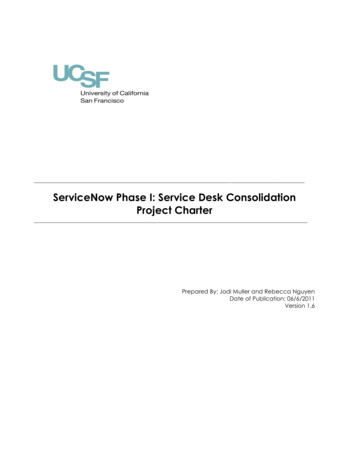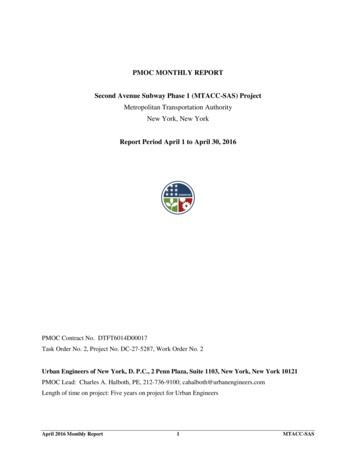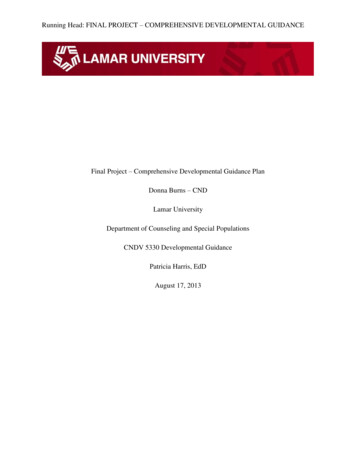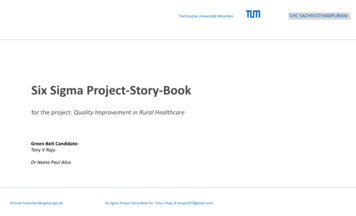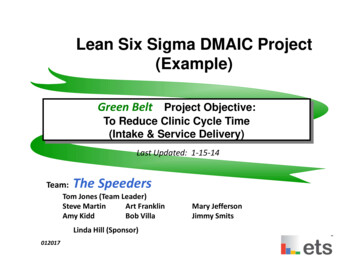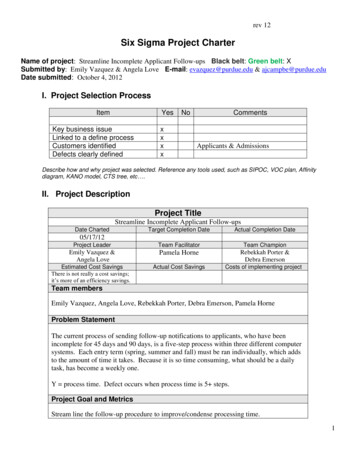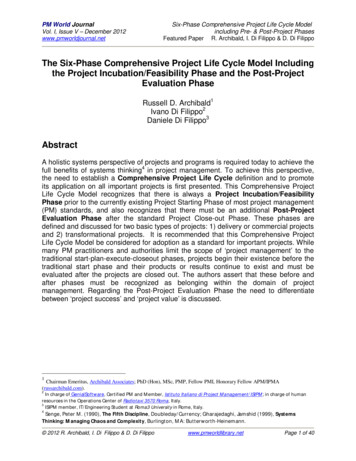
Transcription
PM World JournalVol. I, Issue V – December 2012www.pmworldjournal.netSix-Phase Comprehensive Project Life Cycle Modelincluding Pre- & Post-Project PhasesFeatured Paper R. Archibald, I. Di Filippo & D. Di FilippoThe Six-Phase Comprehensive Project Life Cycle Model Includingthe Project Incubation/Feasibility Phase and the Post-ProjectEvaluation PhaseRussell D. Archibald1Ivano Di Filippo2Daniele Di Filippo3AbstractA holistic systems perspective of projects and programs is required today to achieve thefull benefits of systems thinking4 in project management. To achieve this perspective,the need to establish a Comprehensive Project Life Cycle definition and to promoteits application on all important projects is first presented. This Comprehensive ProjectLife Cycle Model recognizes that there is always a Project Incubation/FeasibilityPhase prior to the currently existing Project Starting Phase of most project management(PM) standards, and also recognizes that there must be an additional Post-ProjectEvaluation Phase after the standard Project Close-out Phase. These phases aredefined and discussed for two basic types of projects: 1) delivery or commercial projectsand 2) transformational projects. It is recommended that this Comprehensive ProjectLife Cycle Model be considered for adoption as a standard for important projects. Whilemany PM practitioners and authorities limit the scope of ‘project management’ to thetraditional start-plan-execute-closeout phases, projects begin their existence before thetraditional start phase and their products or results continue to exist and must beevaluated after the projects are closed out. The authors assert that these before andafter phases must be recognized as belonging within the domain of projectmanagement. Regarding the Post-Project Evaluation Phase the need to differentiatebetween ‘project success’ and ‘project value’ is discussed.1Chairman Emeritus, Archibald Associates; PhD (Hon), MSc, PMP, Fellow PMI, Honorary Fellow APM/IPMA(russarchibald.com).2In charge of GenialSoftware, Certified PM and Member, Istituto Italiano di Project Management/ISIPM; in charge of humanresources in the Operations Center of Radiotaxi 3570 Roma, Italy.3ISIPM member, IT/Engineering Student at Roma3 University in Rome, Italy.4Senge, Peter M. (1990), The Fifth Discipline, Doubleday/Currency; Gharajedaghi, Jamshid (1999), SystemsThinking: Managing Chaos and Complexity, Burlington, MA: Butterworth-Heinemann. 2012 R. Archibald, I. Di Filippo & D. Di Filippowww.pmworldlibrary.netPage 1 of 40
PM World JournalVol. I, Issue V – December 2012www.pmworldjournal.netSix-Phase Comprehensive Project Life Cycle Modelincluding Pre- & Post-Project PhasesFeatured Paper R. Archibald, I. Di Filippo & D. Di FilippoGenesis of this paper: The authors became acquainted early in 2012 via the Internetthrough the Istituto Italiano di Project Management/ISIPM LinkedIn discussion group. After aninitial on-line exchange of ideas, this multi-generational, multi-cultural trio decided tocollaborate to produce this paper. Russell, age 88, an American who has lived in 6 countrieson 3 continents, brings a perspective formed by 62 years in engineering, executive, programand project management across several industries and cultures; Ivano, age 52, an Italian,brings a perspective formed by 20 years in IT, 15 in project management and 25 years incharge of ‘front-end’ human resources in the Operations Center of the largest Radiotaxicompany in Italy and Europe, in addition to his university student years in the medical field;Daniele, age 22, also Italian and the son of Ivano, has of course grown up in the Digital Age,has a strong interest in human behavior, and completed his university degree in ITengineering in July 2012. This unique combination has produced a team effort that hascreated the perspectives presented in this paper. Short CVs of each follow the References.Acknowledgement: The authors wish to acknowledge with gratitude the comments,suggestions, and criticisms of an earlier version of this paper by Wayne Abba, FrancoCaron, Prof. Gianluca Di Castri, Prof. Dr. Jean-Pierre Debourse, Prof. Dr. HaroldKerzner, Prof. Dr. Stanislaw Gasik, David Pells, Dr. Darci Prado, Bob Prieto, and Prof.Jorge Tarazona, whose brief CVs are shown in Appendix A. The content remains solelybased on the opinions of the authors, however, except where quotations are specificallystated.Part 1. IntroductionA company that wants to compete in the international market knows the importance ofadopting a Business Process Management (BPM) model as a holistic managementapproach. The BPM Model is the set of activities needed to define, optimize, monitorand integrate business processes in order to create the desired outcome for eachstakeholder. In addition to driving a company’s on-going operations, Business ProcessManagement (which includes the concept of Business Performance Management) (Ref.1) drives its projects and programs, integrated with their multi-project portfolios toachieve high performance development that is characterized by new success criteria,where project management metrics are based on performance indices as shown by amatrix between KPIs and CSFs (Ref. 2): Key Performance Indicators (KPIs) are commonly used by an organization toevaluate its success or the success of a particular activity in which it is engaged. Critical success factor (CSF) is the term for an element that is necessary for anorganization or project to achieve its mission successfully, and for ensuring thesuccess of a company. Critical success factors are those few things that must gowell to ensure success for a manager or an organization, and therefore theyrepresent those managerial or enterprise areas that must be given special andcontinual attention to bring about high performance.In achieving improved success in project, program, and portfolio management there aretwo desirable goals: 2012 R. Archibald, I. Di Filippo & D. Di Filippowww.pmworldlibrary.netPage 2 of 40
PM World JournalVol. I, Issue V – December 2012www.pmworldjournal.netSix-Phase Comprehensive Project Life Cycle Modelincluding Pre- & Post-Project PhasesFeatured Paper R. Archibald, I. Di Filippo & D. Di Filippo A new way to define more broadly and manage more comprehensively theProject Life Cycles for both the transformational and the delivery projects andprograms within an enterprise; and The proper and effective use of Information Technology (IT) with BusinessProcess Management (BPM) plus Project, Program and Portfolio Management(PPPM.)Use of Information Technology (IT): In order to implement the powerful and widelyused Business Process Modeling software systems and the business software systemsfor managing projects, programs, and their portfolios, we must have integratedinformation models of those projects and programs. Examples of these softwaresystems (applications) are listed in Appendix B. In fact, these powerful systems are theenablers that make it possible to gain the insights of systems thinking in improving allmanagement processes, procedures, and practices. The greatest challenge in thisregard today is to properly integrate project management software with corporate andoperations management software within a large organization5. The full benefits fromapplication of these powerful information systems can only be achieved throughdevelopment of fully integrated project life cycle models that are the subject of thispaper.Project versus Product Life Cycle Management and Models: Since a project endswhen its final results (or products) have been delivered to the owner, investor, marketer,or user in accordance with the project contract or internal project charter, the standardproject life cycle comes to an end when the project close-out phase is complete. Theproduct life cycle begins at the moment the product begins to be used, sold or placed inoperation, thus producing the benefits that justified the project in the first place. Theremay be some overlap between the standard project close-out phase and the initiation ofthe product usage and thus its product life cycle. For consumer products the product lifecycle typically has five phases: introduction, growth, maturity, decline, and termination.There may of course be product improvements (new projects) to extend the product life.If the project produces a new facility, such as a petrochemical processing plant, theproduct life cycle will consist of these phases: commissioning (usually also anoverlapping phase with the project that produced the plant), operation (with periodicmaintenance and modification projects interrupting productive operation),decommissioning, and demolition (including any ecological cleanup.)For an IT software project that produces an information system, the product life cyclephases will include commissioning (placing the system in full operation), operation, anddecommissioning (usually replaced by a new system.) When agile project managementmethods are in use, there will often be a long period of continuous improvement as new5Bob Prieto says: “Often a barrier to effective lifecycle management is a split responsibility within an owner’sorganization for CAPEX [capital expenditures], OPEX [operations expenditures], and sales. Another barrier tolifecycle management systems is often corporate accounting systems which do not provide a total cost ofownership picture that includes initial studies, CAPEX, OPEX, cost of sales and financing costs.” 2012 R. Archibald, I. Di Filippo & D. Di Filippowww.pmworldlibrary.netPage 3 of 40
PM World JournalVol. I, Issue V – December 2012www.pmworldjournal.netSix-Phase Comprehensive Project Life Cycle Modelincluding Pre- & Post-Project PhasesFeatured Paper R. Archibald, I. Di Filippo & D. Di Filippofeatures are added or unforeseen deficiencies are corrected during the projectexecution phase. In these cases it may be difficult to know when the original projectscope has been achieved and to identify exactly when the project has been closed outand the system (product) operation phase begins.Significant versus Small or Trivial Projects: This paper focuses on significantprojects within human organizations. Of course there are many small, simple, relativelyunimportant projects (perhaps fairly informal ‘task forces’) that exist in any organization,and they can usually be managed without the application of the ideas presented here.Determining whether or not a specific project is ‘significant’ enough to requireapplication of these ideas must be accomplished by the responsible managers withineach organization. Any project that is considered to be strategically transformative willbe significant regardless of its size in terms of cost or number of people involved.The Importance of Project Life Cycle Models: All projects consist of a number ofdifferent phases that form the life cycle (or life span) of each project. In the early yearsof the development of modern project management practices it was common to seeeach phase of a project being planned, scheduled, and managed as a separate project,from start to finish of each phase. Frequently a new project manager would take over asthe next phase was started. This usually resulted in many un-resolved design or otherconflicts being swept forward into the next phase, especially in design/construction/fieldoperation projects, as well as in IT projects. The field project manager of a new processplant, for example, had to solve the problems during that construction phase that shouldhave been solved during the design phase. The cost of operating the plant was oftenincreased because the designers and constructors took short-cuts to reduce their costsand increase their profits, but these short-cuts increased the cost of operating andmaintaining the plant.As the project management discipline matured it was recognized that overlapping thesephases when practical will save a considerable amount of time and money, andassuring that one project manager maintains responsibility for the entire project lifecycle forced the resolution of conflicts as early as possible in the project life cycle. Thisled to ‘fast-tracking’6 in the engineering-procurement-construction categories of projects,as well as in many other project categories.As the power of business process and project management information systems grewover recent decades, building on the rapid advances of computer supported systemsand information technology in general, the power and benefits of documenting andintegrating all of the project life cycle phases became more evident and more important.6Bob Prieto says: “’Fast tracking’ was driven by a need to accelerate time to market initially but later wasrecognized as a way to aggregate and transfer risks, particularly those risks in the ‘white space’ between projectphases that were often unmanaged.” 2012 R. Archibald, I. Di Filippo & D. Di Filippowww.pmworldlibrary.netPage 4 of 40
PM World JournalVol. I, Issue V – December 2012www.pmworldjournal.netSix-Phase Comprehensive Project Life Cycle Modelincluding Pre- & Post-Project PhasesFeatured Paper R. Archibald, I. Di Filippo & D. Di FilippoThis led to the development and use today of a number of project life cycle processmodels consisting of a number of phases or stages and related decision points for themany different project categories and sub-categories that exist (Archibald, 2003, pp 4546; see also Appendix C, as discussed later.) The models within each category andsub-category show similarities but in most cases there are significant differences fromone category/sub-category to the next. To be sure, the simplest four-phase life cyclemodel (starting or concept, organizing or definition, execution, and closeout) will be thesame for all categories (PMI 2008, p 16.) But such a simple model is of little practicalvalue in actually planning, authorizing, scheduling, and controlling any complex project.Purposes of Project Life Cycle Process Models: The pu
project life cycle comes to an end when the project close-out phase is complete. The product life cycle begins at the moment the product begins to be used, sold or placed in operation, thus producing the benefits that justified the project in the first place. There may be some overlap between the standard project close-out phase and the initiation of


